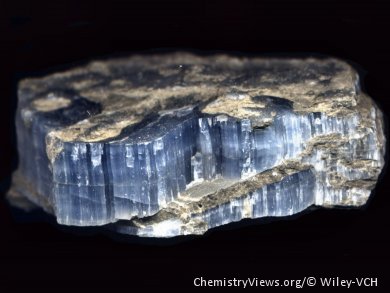Celestine crystallizes in orthorhombic barite-type crystals of the space group Pnma. It forms rhombic dipyramidal crystals in, for example, deposits in fractures and solution cavities in limestone, but also, as in our example, fibrous structures. The chemical composition is SrSO4, strontium sulfate.
The name of celestine was introduced by G. A. Werner in 1798 and refers to the often bluish color of the crystals (coelestis = sky blue). This color is due to F-centers, a type of cystrallographic defect that is also found elsewhere, for example, in the blue Staßfurter rock salt. It forms when under strong radiation (cosmic radiation, radioactive minerals) excites electrons which then are captured by vacancies in the anionic lattice. When celestine is heated above 200 °C these defects heal, thermoluminescence is observed, and the blue color disappears. Conversely, the color can be regained by using strong radiation.
Strontium compounds have little economic significance. Previously, they were used in the sugar industry but today their use is limited to pyrotechnics (as the nitrate, Rotfeuer) and the production of alloys and ceramic products. Strontium sulfate itself is still used in some special toothpastes for “sensitive teeth”, it probably works by blocking the tubules (fine tubes that connect the outer, often exposed, base of the tooth to the inner nerve) as it is the sparingly soluble.
- Celestine is the answer to Guess the Mineral (3).
- Chrysotile is the answer to Guess the Mineral (2).
- Chrome Diopside is the answer to Guess the Mineral (1).
The next mineral quiz will be published in early October.
The lucky winners of Guess the Mineral (3) are N. R. F. Holguín, Mexico, and E. S. Potts, USA.




